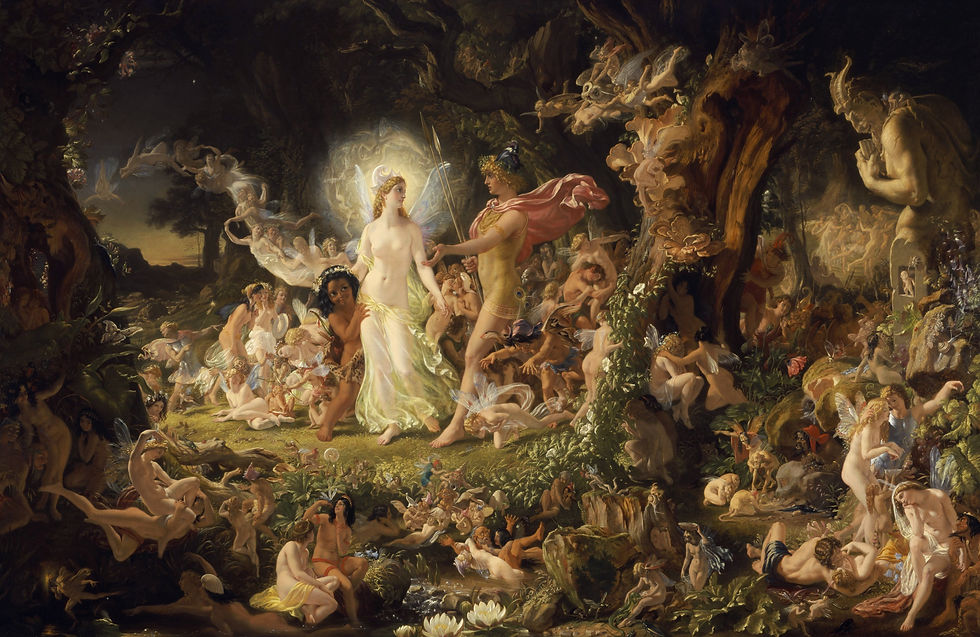What’s in a name?
- James Tyler
- Mar 29, 2023
- 3 min read
Sometimes we forget how bawdy a writer William Shakespeare was. Sure, there’s the intense brilliancy of the “To be or not to be” soliloquy in which Hamlet bleakly contemplates suicide.

But Shakespeare’s plays are riddled with jokes about sex, body parts, flatulence and all manner of saucy bits that would have fit right in on the old Benny Hill comedy shows.
So it’s amusing that many of the moons of one of our solar system’s oddest planets are named for characters from Shakespeare’s plays.
Which planet? Yep, it had to be Uranus.

You’re probably already chuckling. That’s likely because you’re pronouncing the planet’s name in a way that many astronomers don’t use. They say “Yurr-en-us.” Shakespeare would have had a ball with this.
But he died in 1616, and it wasn’t until Sir William Herschel first observed Uranus on March 13, 1781, that the faint object was determined to be the seventh planet in our solar system.
Shakespeare obviously knew the name Uranus because it goes back to Greek mythology.
Uranus was the Greek god of the sky and was the father of Cronus, grandfather of Zeus and great grandfather of Ares. Those three got their own planets that we know as Saturn, Jupiter and Mars.

About six years after he discovered “Yurr-en-us” with the telescope he built, Herschel spotted two of its largest moons. But he just referred to them as the first or second satellite of Uranus.
It wasn’t until 1852 that Herschel’s son, John, chose names for the two moons. And that’s where Shakespeare comes into the picture.
John Herschel could have dipped into Greek or Roman mythology to name those two newly discovered moons. Afterall, Simon Marius named the four moons of Jupiter that Galileo Galilei first discovered in 1609. Galileo was going to name them Cosmica Sidera (Cosimo’s stars). But Marius won out, and the four “Galilean moons” are named after Jupiter’s sexual conquests: Io, Europa, Ganymede and Callisto.

No, Herschel decided to tap one of Shakespeare’s most famous plays for the names of those first Uranian moons. So from “A Midsummer Night’s Dream” we get Titania and Oberon, the queen and king of the fairies. Titania is the largest Uranian satellite, followed by Oberon.
But Shakespeare doesn’t get all the glory in Uranian moon names.
In 1851, William Lassell had discovered two other moons of Uranus. But it was John Herschel who gave all four moons their final names. For the two Lassell discovered he chose Ariel and Umbriel.
Ariel is a sky spirit and Umbriel a melancholy sprite in Alexander Pope’s 1712 poem “The Rape of the Lock.” Ariel is also the name of the spirit character in Shakespeare’s “The Tempest.”
It wasn’t until 1948 that Gerard Kuiper discovered the last of the five largest Uranian moons. He chose to name it after another character from “The Tempest” – Miranda.

Skip ahead to 1986 and the spacecraft Voyager 2 zips by the Uranian system and sends back info on 10 more moons. Those came to be called Juliet, Puck, Cordelia, Ophelia, Bianca, Desdemona, Portia, Rosalind, Cressida and Belinda.
More Uranian moons have been discovered since Voyager’s fly-by. So far the total is up to 27 moons around the solar system’s seventh planet. Of those 27, three are named for characters from Pope’s poem: Ariel, Umbriel and also Belinda.

The other 24 tie back to numerous Shakespearean plays. “The Tempest” for some reason has been the inspiration for the most Uranian moon names. From that play, we get the moons: Miranda, Caliban, Sycorax, Prospero, Setebos, Stephano, Trinculo, Francisco and Ferdinand. “A Midsummer Night’s Dream” gives us Titania, Oberon and Puck.
The other Shakespearean dramas that tie in include “King Lear” with Cordelia; “Hamlet” with Ophelia; “The Taming of the Shrew,” Bianca; “Troilus and Cressida,” Cressida; “Othello,” Desdemona; “Romeo and Juliet,” Juliet, Mab; “The Merchant of Venice,” Portia; “As You Like It,” Rosalind; “Much Ado about Nothing,” Margaret; “The Winter’s Tale;” Perdita; and “Timon of Athens,” Cupid.
And heck, we haven’t even touched on “Macbeth,” “Measure for Measure,” “All’s Well That Ends Well” or any of Shakespeare’s many history plays.
Maybe someday when we start to discover moons orbiting planets beyond our solar system we can tap into other dramatic sources for names.
How about pulling from the “Star Wars” films? Anyone up for moons called Chewbacca, Lando, Padmé or Leia?
Shakespeare’s Juliet famously asks, “What’s in a name?” Turns out, quite a lot really.



Comments